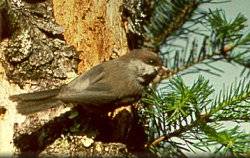- Boreal Chickadee
Taxobox
name = Boreal Chickadee
status = LC | status_system = IUCN3.1

image_width = 250px
regnum =Animal ia
phylum = Chordata
classis =Aves
ordo = Passeriformes
familia = Paridae
genus = "Poecile "
species = "P. hudsonicus"
binomial = "Poecile hudsonicus"
binomial_authority = (Forster,1772 )
synonyms = "Parus hudsonicus"The Boreal Chickadee ("Poecile hudsonicus", formerly "Parus hudsonicus") is a small
songbird , apasserine bird in the tit family Paridae.Adults are 12.5–14.5 cm long with a weight of 7–12.4 g. They have grey-brown upperparts with a brown cap and greyish wings and tail; their face is mainly grey with white on the sides. Their underparts are white with brown on the flanks and a black throat. They have a short dark bill, short wings and a long notched tail.
Their breeding habitat is
conifer ous woods inCanada ,Alaska and the northern edges of theUnited States . They nest in a hole in a tree; the pair excavates the nest, using a natural cavity or sometimes an oldwoodpecker nest. The pair remains together year round and may mate for life.They are permanent residents, but sometimes move south in winter. They often forage with small flocks including other small birds in winter.
These birds forage on conifer branches or probe into the bark. They mainly eat insects and seeds. They will store food for later use.
The call is a husky "tsik-a-dee-dee", a variant on the call which gives chickadees their name.
Often, it is still placed in the genus "Parus" with most other tits, but
mtDNA cytochrome "b" sequence data and morphology suggest that separating "Poecile" more adequately expresses these birds' relationships (Gill "et al.", 2005). TheAmerican Ornithologists' Union has been treating "Poecile" as a distinct genus for some time already. The genus name "Poecile" has often been treated as feminine (giving the species name ending "hudsonica"); however, this was not specified by the original genus authorJohann Jakob Kaup , and under theICZN the genus name must therefore be treated by default as masculine, giving the name ending "hudsonicus" (del Hoyo et al. 2007).References
* Database entry includes justification for why this species is of least concern
*del Hoyo, J., Elliot, A., & Christie D. (eds). (2007). "Handbook of the Birds of the World ". Volume 12: Picathartes to Tits and Chickadees. Lynx Edicions. ISBN 9788496553422
*Gill, F. B., Slikas, B., & Sheldon, F. H. (2005). Phylogeny of titmice (Paridae): II. Species relationships based on sequences of the mitochondrial cytochrome-"b" gene. "Auk" 122: 121-143. DOI: 10.1642/0004-8038(2005)122 [0121:POTPIS] 2.0.CO;2 [http://www.bioone.org/perlserv/?request=get-abstract&doi=10.1642%2F0004-8038%282005%29122%5B0121%3APOTPIS%5D2.0.CO%3B2 HTML abstract]External links
* [http://www.bird-stamps.org/cspecies/16001400.htm Stamps] (for
Canada ) with RangeMap
* [http://vireo.acnatsci.org/search.html?Form=Search&SEARCHBY=Common&KEYWORDS=boreal+chickadee&showwhat=images&AGE=All&SEX=All&ACT=All&Search=Search&VIEW=All&ORIENTATION=All&RESULTS=24 Boreal Chickadee photo gallery] VIREO
* [http://www.mainebirdingtrail.com/BorealChickadee.jpgPhoto-High Res--(Close-up)] ; [http://www.mainebirdingtrail.com/boreals.htm Article] – mainebirdingtrail–"Maine's Boreal Species"
Wikimedia Foundation. 2010.
